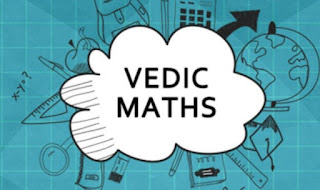VEDIC MATHS-60
VEDIC MATHS
By OMKAR TENDOLKAR
This is post number 60 from the series of "Vedic maths" blogs. Here in this blog we will learn about "Finding Squares of 3-digit number by the Duplex method"
Vedic maths provides a powerful method to compute the square of any number of any length with ease and get the answer in one line. It uses the concept of ‘dwandwa’ or duplex which is explained in this blog.
The Duplex
As the name suggests, duplex simply means dual or something relating to two. We will be using this concept effectively to find out the squares of different numbers. The role of the duplex is to find the squares of numbers.
We will define a term called ‘dwandwa’ or duplex denoted by ‘D’.
Squaring by the Duplex method:
Once the concept of ‘duplex’ is clear, we can compute the square of any number very easily. Let us start with the square of a 3-digit number and then extend it to bigger numbers.
Finding Squares Using the Duplex Method
Three-digit squares :
The square of a 3-digit number abc is defined as
(abc)^2 = Duplex of ( a | ab | abc | bc | c)
= D(a) * D(ab) * D(abc) * D(bc) * D(c)
Examples :
1.(746)^2.
Here a = 7, b = 4 and c = 6
Step 1 :
We’ll first find all the duplexes and write them down. We will find the duplex of a, ab, abc, bc and c.
- The duplex of 7 is (7)^2, which is 49.
- The duplex of 74 = 2 × 7 × 4 = 56.
- The duplex of 746 = (4)^2 + (2 × 7 × 6) = 16 + 84 = 100.
- The duplex of 46 = 2 × 4 × 6 = 48.
- The duplex of 6 = (6)^2 =36.
The duplexes for (746)^2 looks like this: 49|56|100|48|36.
Step 2 :
In this step, we’ll start adding from right to left.
49|56|100|48|36.
= 556516
- First we put down 6 from 36 as the unit’s digit and carry over 3 to the next step.
- We then add 3 to 48, so it becomes 51. Then we put down 1 and carry over5 to the next step.
- 100 + 5 = 105; we now put down 5 and carry over 10.
- 56 + 10 = 66. We repeat the same thing; we put down 6 and carry over 6 to the last step.
- So 49 + 6 = 55 and finally, we take 55 down.
- Our answer is 556516.
(746)^2 = 556516.
2. (357)^2
Here a = 3, b = 5 and c = 7.
Step 1 :
We’ll first find all the duplexes and write them down. We will find the duplex of a, ab, abc, bc and c.
As usual we put down all the duplexes.
- So the duplex of 3 is (3)^2, which is 9.
- The duplex of 35 is 2 × 3 × 5 = 30.
- The duplex of 357 = 52 + ( 2 × 3 × 7) = 25 + 42 = 67.
- The duplex of 57 = 2 × 5 × 7 = 70.
- The duplex of 7 is (7)^2 or 49.
Now we place all the duplexes like this: 9|30|67|70|49
Step 2 :
Now all we have to do is add up these duplexes.
9|30|67|70|49
= 127449
- We’ll put down 9 of 49 in the unit’s place and then carry over 4 to the next column.
- So 70 + 4 (carried over) = 74; we will put the 4 down in the ten’s place and carry over 7 to the next column.
- Now 67 + 7 = 74 again. So we’ll put 4 down in the hundred’s place and carry over 7 to the next column.
- 30 + 7 = 37. We’ll place 7 in the thousand’s place and carry over 3 to the next column.
- And finally, 9 + 3 = 12, which brings us to our final answer 127449.
Answer:
(357)^2 = 127449.
- (212)^2 = 4| 4| 9| 4| 4 = 44944
- (315)^2 = 9| 6|31|10|25 = 99225
- (239)^2 = 4|12|45|54|81 = 57121
- (227)^2 = 4| 8|32|28|49 = 51529
- (515)^2 = 25|10|51|10|25 = 265225
In next blog we will discuss about "Finding Squares of 4-digit number by the Duplex method".
We will meet very soon through our next blog. Till that stay connected, stay healthy and stay safe.
Thanks
for giving your valuable time.


It's very useful in competitive exams, All the best .
ReplyDelete